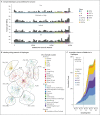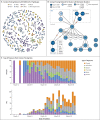Spread of SARS-CoV-2 in the Icelandic Population
- PMID: 32289214
- PMCID: PMC7175425
- DOI: 10.1056/NEJMoa2006100
Spread of SARS-CoV-2 in the Icelandic Population
Abstract
Background: During the current worldwide pandemic, coronavirus disease 2019 (Covid-19) was first diagnosed in Iceland at the end of February. However, data are limited on how SARS-CoV-2, the virus that causes Covid-19, enters and spreads in a population.
Methods: We targeted testing to persons living in Iceland who were at high risk for infection (mainly those who were symptomatic, had recently traveled to high-risk countries, or had contact with infected persons). We also carried out population screening using two strategies: issuing an open invitation to 10,797 persons and sending random invitations to 2283 persons. We sequenced SARS-CoV-2 from 643 samples.
Results: As of April 4, a total of 1221 of 9199 persons (13.3%) who were recruited for targeted testing had positive results for infection with SARS-CoV-2. Of those tested in the general population, 87 (0.8%) in the open-invitation screening and 13 (0.6%) in the random-population screening tested positive for the virus. In total, 6% of the population was screened. Most persons in the targeted-testing group who received positive tests early in the study had recently traveled internationally, in contrast to those who tested positive later in the study. Children under 10 years of age were less likely to receive a positive result than were persons 10 years of age or older, with percentages of 6.7% and 13.7%, respectively, for targeted testing; in the population screening, no child under 10 years of age had a positive result, as compared with 0.8% of those 10 years of age or older. Fewer females than males received positive results both in targeted testing (11.0% vs. 16.7%) and in population screening (0.6% vs. 0.9%). The haplotypes of the sequenced SARS-CoV-2 viruses were diverse and changed over time. The percentage of infected participants that was determined through population screening remained stable for the 20-day duration of screening.
Conclusions: In a population-based study in Iceland, children under 10 years of age and females had a lower incidence of SARS-CoV-2 infection than adolescents or adults and males. The proportion of infected persons identified through population screening did not change substantially during the screening period, which was consistent with a beneficial effect of containment efforts. (Funded by deCODE Genetics-Amgen.).
Copyright © 2020 Massachusetts Medical Society.
Figures




Comment in
-
Early Spread of SARS-CoV-2 in the Icelandic Population.N Engl J Med. 2020 Nov 26;383(22):2184. doi: 10.1056/NEJMc2027653. Epub 2020 Nov 4. N Engl J Med. 2020. PMID: 33147383 No abstract available.
References
-
- Drosten C, Günther S, Preiser W, et al. Identification of a novel coronavirus in patients with severe acute respiratory syndrome. N Engl J Med 2003;348:1967-1976. - PubMed
-
- Ksiazek TG, Erdman D, Goldsmith CS, et al. A novel coronavirus associated with severe acute respiratory syndrome. N Engl J Med 2003;348:1953-1966. - PubMed
Publication types
MeSH terms
LinkOut - more resources
Full Text Sources
Other Literature Sources
Medical
Research Materials
Miscellaneous
